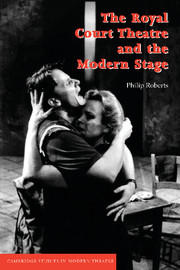Book contents
- Frontmatter
- Contents
- Foreword by Max Stafford-Clark
- Preface
- Acknowledgements
- List of abbreviations
- Biographical notes
- Introduction: abortive schemes, 1951–1954
- 1 Coincidences, 1954–1956
- 2 The struggle for control, 1956–1960
- 3 Conflict and competition, 1961–1965
- 4 A socialist theatre, 1965–1969
- 5 A humanist theatre, 1969–1975
- 6 Changing places, 1975–1979
- 7 Theatre in a cold climate, 1980–1986
- 8 Holding on, 1987–1993
- Afterword
- Notes
- Select bibliography
- Index
Foreword by Max Stafford-Clark
Published online by Cambridge University Press: 22 September 2009
- Frontmatter
- Contents
- Foreword by Max Stafford-Clark
- Preface
- Acknowledgements
- List of abbreviations
- Biographical notes
- Introduction: abortive schemes, 1951–1954
- 1 Coincidences, 1954–1956
- 2 The struggle for control, 1956–1960
- 3 Conflict and competition, 1961–1965
- 4 A socialist theatre, 1965–1969
- 5 A humanist theatre, 1969–1975
- 6 Changing places, 1975–1979
- 7 Theatre in a cold climate, 1980–1986
- 8 Holding on, 1987–1993
- Afterword
- Notes
- Select bibliography
- Index
Summary
I recall attending an academic conference at Baton Rouge, Louisiana, in the early eighties which took the history of The Royal Court as its subject. A number of us had been flown in at considerable expense to the heart of bayou country.
After three days of genial bickering and disagreement about almost every aspect of the Royal Court's provenance and history, one of our gracious hosts asked if there was any aspect of the Royal Court we could agree on. It turned out that there wasn't, so the requirement for an objective and comprehensive history of this important theatre is well due.
It is hard to write about such a passionate theatre in a dispassionate and accurate way, but Philip Roberts' rich account, which covers the history of the Royal Court from its inception in 1956 to the end of the millennium, is invaluable to anybody interested in theatre, and is intriguing for those of us who had the pleasure of playing some part in those events.
No other theatre in England attracts more passion to itself than the Royal Court. Several generations of writers and directors have held the mirror up to their society and defined their times on its stage. In 1993, the year I left, it was called both ‘Europe's most interesting theatre’ by the New York Times and ‘a dump’ by our own Sunday Times. I hoped that both statements contained an element of truth.
- Type
- Chapter
- Information
- The Royal Court Theatre and the Modern Stage , pp. xi - xiiPublisher: Cambridge University PressPrint publication year: 1999



